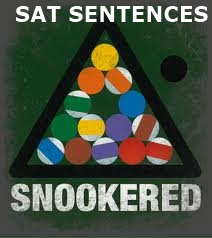 Assuming the meaning of an unknown word in SAT Sentences can get you SNOOKERED. (To trick, entice, or trap...what the test designers eat for breakfast.)
Try this sentence...
Commentators on presidential campaigns often claim that relevant debates on issues are damaged by a _____ of condemnations and accusations that precludes ___________ conversations.
A) collection…expendable B) dearth…meaningful
C) blast…defamatory D) reiterative…repetitive
E) babel…reasonable
Try to pick an answer before you read on.
Most students do not know what “precludes” means. Most students assume that “precludes” means something like “to include beforehand”. These students are basing that assumption on “Prefix-Suffix-Roots”, a dangerous thing to do on The SAT. Most students do not realize that “precludes” controls the slot. It is the key to the sentence.
Even though the “global” result of the sentence is negative, does that mean that the second slot is negative? If a student has made the wrong assumption about “precludes”, that student will likely pick © as the answer, especially in the face of “babel”.(A scene of noisy confusion.)
Precludes—to prevent or to make something impossible.
Therefore, the babel of condemnations makes an reasonable conversation impossible. Correct Answer: E
Notice that “precludes” controls the slot and, in effect, switches what seems to be a negative to a positive…”REASONABLE”.
Beware of unknown words, especially adjectives or verbs, that control the slot. These words can SWITCH the expected meaning of the slot from Negative to Positive, or vice versa.
Don't assume. Don't get Snookered.
http://www.facebook.com/l.php?u=http%3A%2F%2Fwww.huffingtonpost.com%2Fkat-cohen%2Fsummer-vacation-and-college-admissions_b_1527635.html%3Fref%3Dfb%26src%3Dsp%26comm_ref%3Dfalse&h=xAQFLzcCoAQFdv8lTXHMO12IgcfxlMV6oimy5ediU-zouYw&enc=AZM_shGbIUvaEtzrc7g1NJ_A9RgzIEFXcf0ISFI9ty5h_S5fUKlwOJNKr6gfBUOMM8HbxABHF6rnZpjIelvHr-EYI like this idea: Create a Customized CurriculumOne of the most accessible and affordable options for students is to create your own curriculum. Students can develop this by utilizing online courses on a particular topic and pairing the courses with an extensive reading list. With the help of open courseware providers including MIT, Yale University, Khan Academy, Academic Earth, and Coursera, you can spend the summer immersed in works related to your chosen topic. Ask your teachers and the school librarian for reading list recommendations before the school year ends. While you work your way through the courses and reading list, keep an annotated bibliography, which you can later submit with your college applications. Similarly, students can design an independent research project. If you choose this course of action, your goal should be to produce a final, tangible product such as a paper or entry into a competition or fair. You may be able to use resources at a local college such as their faculty and facilities. In addition to the personal and intellectual growth designing a curriculum can provide you, it will also serve as a demonstration of your academic interests to college admissions officers.Lots of links to Free Open Courses over on our Facebook Timeline. https://www.facebook.com/SelectPrep
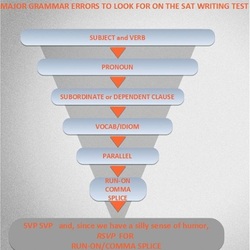 The SVP Funnel lists the major errors that are on the Grammar portion of the SAT Writing test. An explanation of each of these errors is in various posts on . https://www.facebook.com/SelectPrep You should also be aware of Redundancy. Redundancy shows up a lot more on the ACT than on the SAT, but you still need to be aware of it. Redundancy: the construction of a phrase that presents some idea using more information than is necessary for one to be able to understand the idea. An unnecessary or unessential repetition of meaning, using different and dissimilar words that effectively say the same thing twice. I am going to permanently lose weight, and keep it off. At first, I initially was afraid of swimming. My first class begins at 10 a.m, in the morning. It looks like it's going to be a busy weekend on the ferries, particularly Saturday and Sunday.
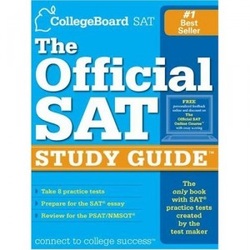 SHOULD I MEMORIZE LOTS OF SAT VOCAB? Studying vocabulary is, for most students, a reasonable use of SAT prep time, However, it's not the number of SAT words you know. It's understanding how the SAT designers use those words. The SAT does not actually test your vocabulary. It tests your reasoning ability. The harder questions are made difficult, not by testing fancy words, but by testing what students ASSUME about the meanings of words, especially seemingly easy words. Here's a famous example of Assuming the meaning of an unknown word...from a past SAT: Actors in melodramas often emphasized tense moments by being ________, for example, raising their voices and pretending to swoon. A) imperious B) inscrutable C) convivial D) histrionic E) solicitous This sentence highlights the SAT designer's realization that most students will assume the meaning of a word based on “sounds like, looks like, tastes like”. In SelectPrep's experience, over 70% of beginning students quickly crossed out “histrionic”. “No way that “history” means swooning!” Our students learn that roots, prefixes, sounds like, looks like are not to be trusted. “Histrionic” = “raising their voices and pretending to swoon.” Our students learn to think like SAT designers. Quickly eliminating words that seem obviously wrong can get you in a whole bunch of trouble. Here's another example: The judges for the chili competition were -------, noting subtle differences between dishes that most people would not detect. (A) obscure (B) deferential (C) discriminating (D) sanctimonious (E) unrelenting The word that goes in the blank needs to mean "noting subtle differences" and it needs to be positive. Most students got this question wrong, because most students quickly crossed out C-they assumed that discrimination is a bad word. They did not realize that "discriminating" might have other levels of meaning. Like "a discriminating palette". Or, another way to put it, "noting subtle differences". Secondary word meanings, and words with metaphorical meanings are more often right than wrong on an SAT test. Pay close attention to "easy" words on hard questions: If the question seems hard to you, and you see a simple, everyday word that SEEMS to be obviously wrong, do not ASSUME. Do not automatically cross out that word. The College Board people are about to do a GOTCHA on you. I am not suggesting that you should always pick that word, but if you cross it out and then find it difficult to find the answer, you have probably been snookered. (Also, what does that tell you about the so-called “Eliminate and Guess strategy? But that's a topic of a future post.) Everyone agrees that a great vocabulary will help a student score higher, but it's such an "odds game" that I have given much more emphasis to understanding how SAT vocab works. Of course I ask my students to study vocab. However, in the limited time that I have with my students, can I "teach" vocab? In short, my approach is that the SAT people know that students will make an assumption about the meaning of words based on prefixes, roots, suffixes. Or that most students will assume only the first level of a word's meaning. Isn't that what most students learn in school? The SAT people also know that. That's why they set so many traps based on ASSUME. Here are more examples from The Blue Book. The Official SAT Study Guide, 2nd edition. If you don't already own this book, buy it. http://www.amazon.com/The-Official-SAT-Study-Guide/dp/0874478529/ref=sr_1_1?s=books&ie=UTF8&qid=1331660910&sr=1-1
Sentences Page 390, Q 4, D Deliberate Page 425, Q 4, E Currency Page 458, Q 8, A Mercurial Page 520, Q 8, C Discriminating Page 734, Q 6, in the Q itself: Precludes Page 842, Q 8, A Censures Reading Page 707, Q6, C Appreciation Page 725, Q12, B Resigned Page 825, Q 9, B Qualified Page 829, Q 21, in the Q itself: Patent
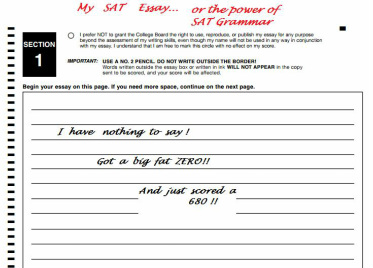 No one would suggest that you write nothing on the SAT Essay. But, my “Reduction to the Absurd Argument” is simply intended to show you the power of the Grammar portion of the test.
The essay score counts for about 30 percent of the writing score, while the grammar score counts for about 70 percent. A lot of students - and a lot of test-prep courses - will spend an inordinate amount of time on the Essay section. But this is probably not the best way to structure your SAT studying time. Especially if you are time-constrained.
Take a look at this example of an SAT score sheet...The Multiple ChoiceGrammar vs. The Essay.
THE SCALE.
R
A
W
G
R
A
M
M
A
R
S
C
O
R
E
ESSAY SCORE
12---11--10-- -9-- -8--- 7--- 6--- 5--- 4-- 3--- 2--- 0
49 800 800 800 800 790 770 750 730 720 700 690 680
If you were to receive a “0” on the essay, but Ace the grammar,
you would still score a 680. If you were to score only a “9” on
the essay, you could still score an “800” on the entire Writing Test!
If you were to score only a “4” on the essay, you would still be above “700” on the entire test. The proof is in the numbers. I am not claiming that 49 points on the grammar is easy to achieve, but play a little calculating game with this scale. Go down the left hand column and pick a grammar raw score. Then line up that number with an essay score at the top. You will see the power of learning SAT Grammar.
12---11--10-- -9-- -8--- 7--- 6--- 5--- 4-- 3--- 2--- 0
48 800 800 800 780 760 750 730 710 700 680 670 660
47 800 790 770 760 740 720 700 690 670 660 640 630
46 780 770 750 740 720 700 690 670 650 640 620 610
45 770 750 740 720 700 690 670 650 640 620 610 600
44 750 740 720 710 690 670 660 640 630 610 590 580
43 740 730 710 700 680 660 640 630 610 600 580 570
42 730 720 700 690 670 650 630 610 600 580 570 560
41 720 710 690 670 660 640 620 600 590 570 560 550
40 710 690 680 660 640 630 610 590 580 560 550 540
39 700 680 670 650 630 620 600 580 570 550 540 530
38 690 680 660 640 630 610 590 570 560 540 530 520
37 680 670 650 640 620 600 580 560 550 530 520 510
36 670 660 640 630 610 590 570 560 540 530 510 500
35 660 650 630 620 600 580 560 550 530 520 500 490
34 650 640 620 610 590 570 560 540 520 510 490 480
33 650 630 620 600 580 560 550 530 520 500 480 470
32 640 620 610 590 570 550 540 520 510 490 480 470
31 630 620 600 580 570 550 530 510 500 480 470 460
30 620 610 590 580 560 540 520 510 490 480 460 450
29 610 600 580 570 550 530 520 500 480 470 450 440
28 610 590 580 560 540 520 510 490 480 460 440 430
27 600 590 570 550 540 520 500 480 470 450 440 430
26 590 580 560 550 530 510 490 480 460 440 430 420
25 580 570 550 540 520 500 480 470 450 440 420 410
24 580 560 550 530 510 490 480 460 450 430 410 400
23 570 550 540 520 500 490 470 450 440 420 410 400
22 560 550 530 520 500 480 460 440 430 410 400 390
21 550 540 520 510 490 470 450 440 420 410 390 380
20 550 530 520 500 480 460 450 430 420 400 380 370
19 540 520 510 490 470 450 440 420 410 390 380 370
18 530 520 500 490 470 450 430 410 400 380 370 360
17 520 510 490 480 460 440 420 410 390 380 360 350
16 510 500 480 470 450 430 420 400 390 370 350 340
15 510 490 480 460 440 420 410 390 380 360 340 330
14 500 490 470 450 440 420 400 380 370 350 340 330
13 490 480 460 450 430 410 390 380 360 340 330 320
12 480 470 450 440 420 400 380 370 350 340 320 310
11 470 460 440 430 410 390 380 360 350 330 310 300
10 470 450 440 420 400 380 370 350 340 320 300 290
9 460 440 430 410 390 370 360 340 330 310 300 290
8 450 430 420 400 380 370 350 330 320 300 290 280
7 440 430 410 390 380 360 340 320 310 290 280 270
6 430 410 400 380 360 350 330 310 300 280 270 260
5 420 400 390 370 350 330 320 300 290 270 260 250
4 410 390 380 360 340 320 310 290 280 260 240 230
3 390 380 360 350 330 310 290 280 260 250 230 220
2 380 360 350 330 310 290 280 260 250 230 220 200
1 360 350 330 320 300 280 260 240 230 210 200 200
0 340 330 310 300 280 260 240 230 210 200 200 200
 The SAT Reading questions are designed to make you lose control of the question. How much gobbledygook is there in an SAT question, especially Reading questions? How often has the following test scenario happened to you?...
You read a passage, then the first question. Then you go back to the passage, looking for the right answer. Then back to the answers, back to the passage, back to the answers…and so on. Do you know what’s happened to you?
You’ve lost control of the question! You probably never had control of the question! If you lose the Question, will you have any idea what to look for in the answers?
If you don't understand the question well enough to answer it, the odds are VERY GOOD that you will cross out the correct answer right from the start.
Here's how to avoid this problem...Do the YOW.
YOW=Your Own Words. Reword the question, always asking: "What does this have to do with the Main Idea?" Quite often, you will reduce the complex question to "Why did the author write these lines?" And, always add the following to your reworded question: "What does it have to do with the Main Idea?" Since the correct answer, most of the time, will be the Main Idea, this YOW step forces you to formulate an answer in your brain BEFORE you consider the answers.
Here's an example from The College Board Official SAT Study Guide, Test 10, pp 962-963. " The author sugests that 'thinking simply' (line 33) works because..." Here's the YOW: Why did he write "thinkly simply", and does it have anything to do with his main idea?
Try this technique yourself, being careful to reread the lines both up and down from Line 33, asking yourself: Why did he write this? Why did he write this? Now sum up in your own words what you think the answer is.
The answer that will pop into your brain will be based on lines 36 and 37: "Before doing anything else, abstract out all irrelevant details!" Get rid of the details. Get rid of the details. Isn't that what the author is saying, in your own words? The entire passage's main idea? Get rid of the details. You now have the answer sitting in your brain. You now have something to match up with the SAT answer. Look at (B)... some problems can be solved if details are ignored. Isn't this the same concept that's in your brain?
Don't look at the answers unless you already have a sense of what to look for. The YOW forces the constant application of the Main Idea. You will also recognize that rare question that is a "detail" question. You will realize that it makes no sense to consider an answer unless you have a clear idea of what that answer SHOULD BE.
One other point:
Occasionally the correct answer will be contrary to the author's POV, but that contrariness will be clearly stated in the question, which will usually reference lines in which the author is discussing an opposing idea. However, that contrariness will still be directly related to the author's Main Idea.
Another point...Occasionally a question will reference an entire paragraph. When you YOW a paragraph question, simply ask yourself what role or function that paragraph plays in the passage as whole, and does it have anything to do with the main idea?
Practice this technique with other reading questions in your BlueBook. If you have questions or comments, please post them here. We promise that you will get an answer.
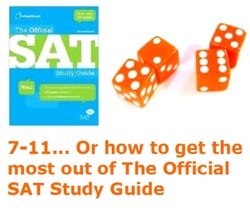 Most students, especially the hard working ones, complete most if not all of the SAT tests in the Official Guide. But most students also neglect a very common sense approach to self-prep. Here it is...
Don't ever do a new test, or even a new section, unless you have learned something from an older, already completed test. It's what we call the 7/11 Routine.
Go back to one of your older SAT practice tests. Look for your wrongs or omits. Now do those questions over, asking yourself: WHAT DID I NOT DO? HAD I DONE WHAT I DID NOT DO, WOULD THAT HAVE GIVEN ME A DIFFERENT RESULT? If you do this process carefully and deliberately, you will complete a maximum of 3 questions in from 7 to 11 minutes. If you complete more than 3 questions, you are probably not being intense enough in your review. You need to ID the specific reasons why you had such a tough time with the question in the first go-round. You need to become your own tutor. "If I say it, it's wrong. If you say it, it's right." If you tell yourself exactly what you did not do, how powerful is that process as a learning tool?
The example below is based on a real SAT passage from The Official Guide (Test 9, Q 15) about a doctor who injures his right hand, only to discover that he is adapting to his injury by becoming quite adept at using his left hand. He starts to wonder about the whole question of adaptation. He says that “there must be changes going on with some of the programs and circuits in my brain”. One of the harder questions in this passage simply asks about this wondering. Here's the question: “ The author’s remark can best be described as?” Basically, what's going on in the Doc's mind? The possible answers: Conjecture, Irony, Inquiry, Observation, Evidence.
Let's say that you got this question wrong. But you had the right 50-50: Conjecture and Observation. Your 3 cross-outs were right on-you just picked the wrong 50-50. You picked Observation. Happens a lot, NO? Let's paint a little scenario. One of your 50-50s was an unknown word, "conjecture". At least you didn't cross out what you don't know. But were you a little afraid to pick what you don't know? Here's where the SAT folks get real cute. Your other 50-50 was an seemingly TRUE STATEMENT which appeared right in the first paragraph! So, with the unknown "conjecture" staring at you, and scaring you, you picked the seemingly TRUE STATEMENT as your answer. Guess what happened to you? YOU LOST CONTROL OF WHAT THE QUESTION WAS ASKING: “ And you were afraid of the unknown. The question: The author’s remark can best be described as?”The TRUE STATEMENT trap is based on your losing control of the question, or never having control of the question from the git-go. You picked an answer that was seemingly TRUE, but that answer had nothing to do with the question. You need to ask yourself: why did I do that?
Here are the possibilities, and here's what you can teach yourself...
I was afraid of the unknown word.
I lost control of the question, or never had control of the question.
I did not repeat the question to myself, or at least ask myself: "Hey, answer-are you the real answer to the question?" Or are you simply TRUE?
Do this process, and here's what you will have learned...
A. Don't be afraid of the unknown. The unknown word, more often than not, is My Friend.
Think about this...On a really tough question, are the SAT people going to make the answer "Apple", or "Conjecture"? Had you known that conjecture means the expression of an opinion or theory without sufficient evidence for proof, a speculation, a guess, would you have picked observation? Don't get me wrong. I am not suggesting that you always pick the unknown word as the answer. But if you are staring at a solid 50-50 with one of the 50-50s an unknown word, then pick the known word only if you are 1000% certain that the known word is correct. Is that Guessing, or is it Solid Logic?
B. Control the question, and don't lose the question.
At the last moment before picking an answer, always ask: Hey, answer, are you the real answer to the question, or are you simply TRUE?
The moral of this little story. Don't ever do a new test unless you have learned something from an old test. The 7/11 Routine. If you teach yourself, you will never forget what you learn.
|






 RSS Feed
RSS Feed